The TITAN X is Nvidia’s fourth GeForce GPU based on 16nm Pascal architecture. It is much faster than the GTX 1080 – until today, the world’s fastest GPU – that we reviewed at the beginning of May. It is also considerably more expensive compared with the GTX 1080 which launched at $699 for the reference Founders Edition. The GTX TITAN X is premium-priced starting at $1200 for the only edition available directly from Nvidia that we are testing today, and they were just made available for purchase this morning. The TITAN X will compete in gaming only with multi-GPU solutions, and it is a hybrid card that is also useful for Single Precision (SP) and Deep Learning compute programs besides for top gaming systems.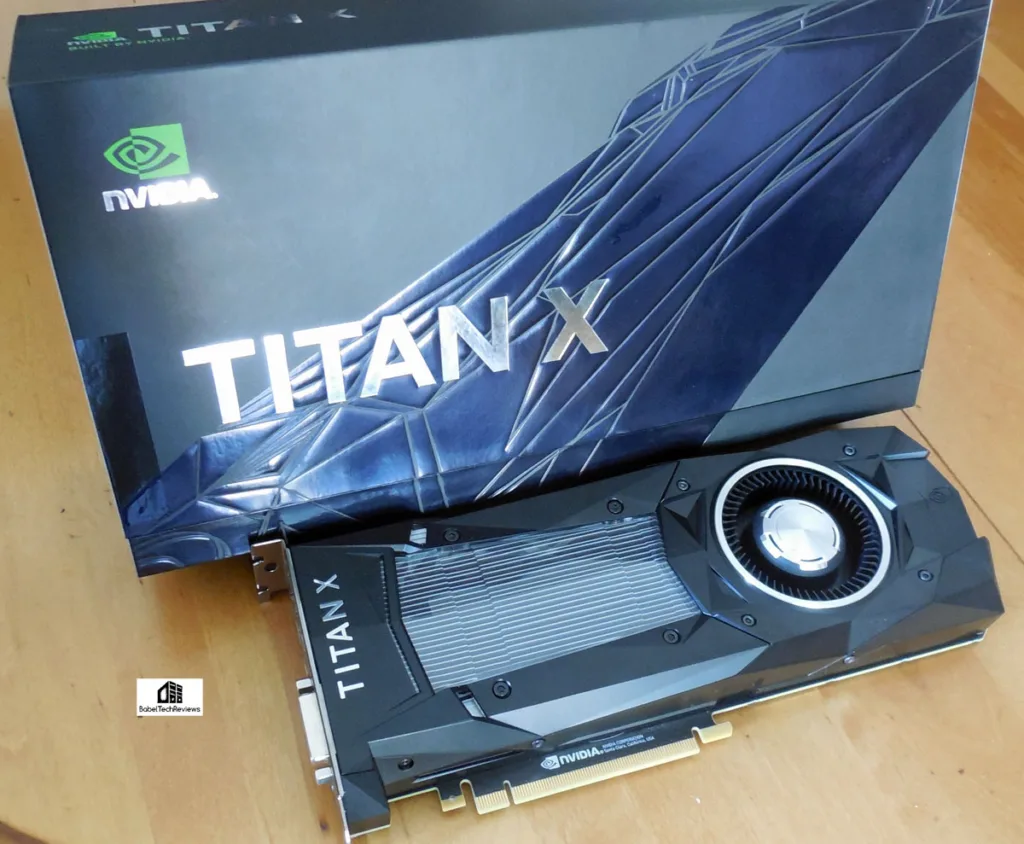
This evaluation will serve as the introduction to our 5-part mini-series on the TITAN X. In this Part 1, we are only going to cover a few benchmarks at 4K and at 1440P against the GTX 1080. We just received our TITAN X for testing this afternoon from Nvidia together with a 2K 34″ ACER Predator G-SYNC display.  For the rest of our TITAN X series, we will bench our top cards at 3440×2160, at 3440×1440, and at 2560×1440. Running the TITAN X at 1920×1080 is beyond overkill and will be bottlenecked by our Core i7-6700 at 4.4GHz.
For the rest of our TITAN X series, we will bench our top cards at 3440×2160, at 3440×1440, and at 2560×1440. Running the TITAN X at 1920×1080 is beyond overkill and will be bottlenecked by our Core i7-6700 at 4.4GHz.
Part 2 of our TITAN X mini-series will be posted this weekend and it will use our entire 25 game benchmark suite to compare with the GTX 1080. Shortly after, Part 3 will compare this new Pascal TITAN X with our Maxwell TITAN X and with the GTX 980 Ti to see how much progress has been made, and Part 4 will be devoted to overclocking the TITAN X. Finally, our last segment will be devoted to Compute and to Deep Learning TITAN X benchmarks.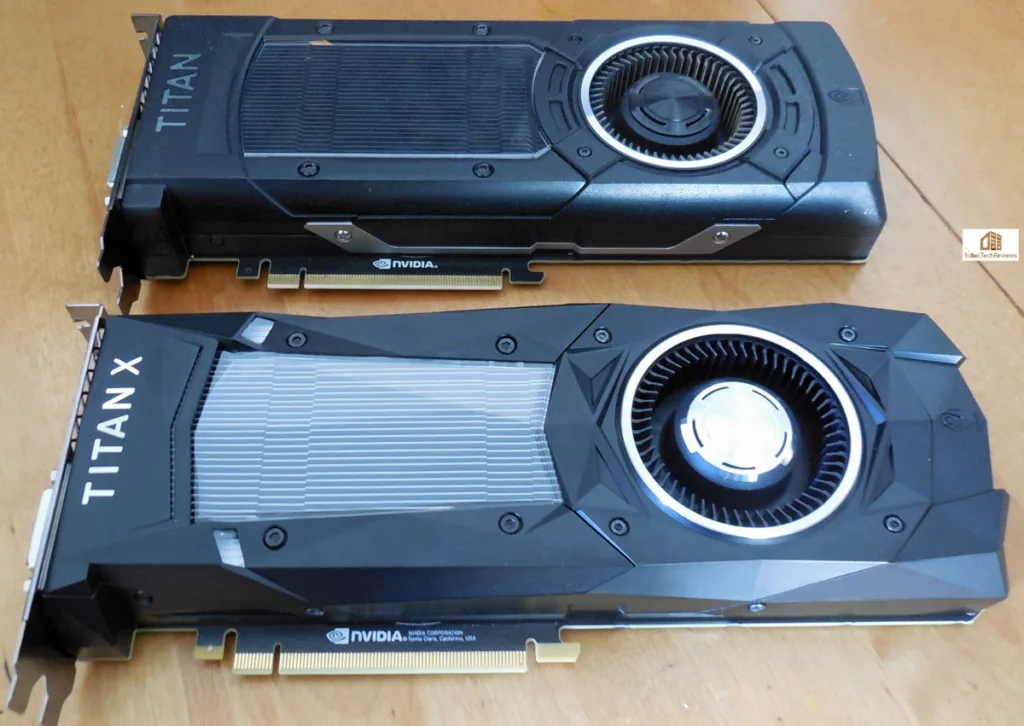
Instead of repeating all of the same information in our GTX 1080 launch review, we are going to highlight the differences between it and the TITAN X. The TITAN X is not based on the GTX 1080’s GP104 GPU, but it has far more in common with the brand new Quadro P6000 which was launched at SIGGRAPH last week. The specifications of the Titan X and the Quadro P6000 are similar and they are both based on GP102. The Quadro is the full chip, 3840 CUDA cores – all 30 of 30 SMs are enabled whereas the Titan X has 28 of 30 SMs as it is configured differently for a total of 3584 CUDA cores. The Titan X comes equipped with 12GB of GDDR5X whereas the Quadro P6000 has 24GB of EEC GDDR5X.
However the TITAN X is still a gaming card, and it supports all of the same new features that Nvidia’s Pascal architecture brings. Pascal delivers high clock speeds while using relatively little power – the GeForce TITAN X runs over 1.5 GHz. Pascal’s 16nm manufacturing process allows the TITAN X to perform faster than Maxwell generation GPUs giving it a huge performance lead over the older TITAN X.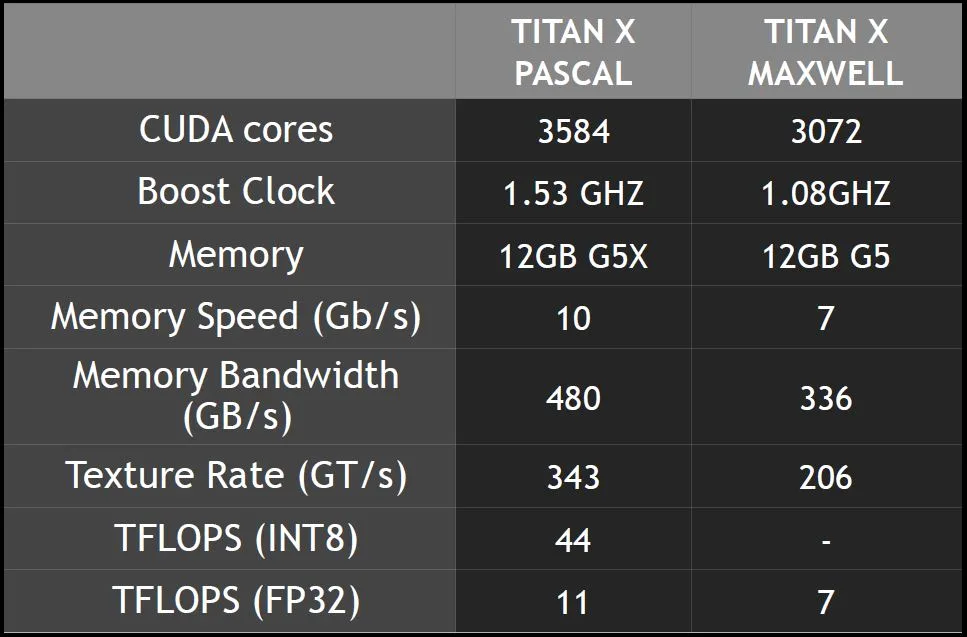
Our testing platform is Windows 10 Home 64-bit, using an Intel Core i7-6700K at 4.00GHz which turbos to 4.4GHz for all cores as set in the ASRock Z7170 motherboard’s BIOS, and 16GB of G.SKILL DDR4 at 3000MHz. The settings and hardware are identical except for the drivers being tested.
Today we are featuring just 5 of our 2016 games, and we are also including Ashes of the Singularity, Hitman, and Rise of the Tomb Raider using DX12. We have also added Total War Warhammer’s newly released DX12 built-in beta benchmark to our regular benching suite plus Futuremark’s just released DX12 benchmark, Time Spy.
Specifications and Features of the TITAN X
Before we give you the results of our performance testing, we want to briefly cover Pascal architecture, as well as detail the specifications and features of the new TITAN X. Since we benchmark 25 games, we have a much larger benchmark suite than any other English-speaking tech site in the world, so we are going to concentrate on performance and we will only briefly summarize the new features of the TITAN X.
Features of the Pascal TITAN X
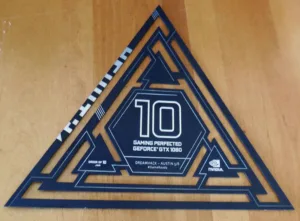 Pascal offers large increases in performance, memory bandwidth, and power efficiency over the current Maxwell architecture. It introduces new graphics features and technologies that confirm the PC as the ultimate platform for playing AAA games and for enjoying virtual reality. All of the features found in the GTX 1080 are also present in the TITAN X and we would highly recommend looking back at our GTX 1080 launch article. In addition, TITAN X is well suited for compute and deep learning Single Precision programs. However, this is a very brief summary:
Pascal offers large increases in performance, memory bandwidth, and power efficiency over the current Maxwell architecture. It introduces new graphics features and technologies that confirm the PC as the ultimate platform for playing AAA games and for enjoying virtual reality. All of the features found in the GTX 1080 are also present in the TITAN X and we would highly recommend looking back at our GTX 1080 launch article. In addition, TITAN X is well suited for compute and deep learning Single Precision programs. However, this is a very brief summary:
Nvidia sums up Pascal’s features as being “the Perfect 10”, this being the GeForce ten series beginning with the release of the GTX 1080, and now, culminating in the TITAN X
Nvidia has engineered the Pascal architecture to handle the demanding computing and gaming needs of technologies like VR. It incorporates several new technologies:
- Next-Gen GPU Architecture. Pascal is optimized for performance per watt. The TITAN X as well as the GTX 1080/1070/1060 are about 3x more power efficient than the Maxwell Architecture.
- 16nm FinFET Process. The TITAN X, the GTX 1080, the GTX 1070, and the GTX 1060 are designed for the 16nm FinFET process, which uses smaller, faster transistors that are packed together more densely to deliver a significant increase in performance and efficiency.
- Advanced Memory. The TITAN X uses 12GB of the fastest available GDDR5X memory at 10000MHz while the GTX 1080 uses 8BG of GDDR5X memory at the same speeds. This is a big jump over the 8000MHz memory used in the Maxwell TITAN X.
- Superb Craftsmanship. Increases in bandwidth and power efficiency allow the TITAN X to run at really high clock speeds. New to Pascal is asynchronous compute. And new GPU Boost 3 technology supports advanced overclocking functions.
- Groundbreaking Gaming Technology. New VRWorks software features let game developers bring more immersion to gaming environments. And Nvidia’s Ansel technology lets gamers share their gaming experiences and explore gaming worlds in new ways.
- All Pascal GPUs feature an all-new SMP Engine which is located within the PolyMorph Engine. With this feature, the GPU can simultaneously map a single primitive on up to sixteen different projections from the same viewpoint. It allows Pascal GPUs to accurately match the curved projection required for VR displays, the multiple projection angles required for surround display setups, and other emerging display use cases. In extreme cases, the SMP Engine can reduce the amount of required geometry work by up to 32x!
The next generation of games will not only look better but run faster on the TITAN X, the GeForce GTX 1080, the GTX 1070 and the GTX 1060. Nvidia has developed a number of advancements for virtual reality – reducing latency, improving image quality, and bringing a whole range of new content to Virtual Reality.
The Pascal GPUs
GP104
First, take a look at the GTX 1080 block diagram which proved to be the world’s fastest GPU – until today.
The GTX 1080 GPU has all 4 Graphics Processing clusters enabled with 64 Raster Operating Units, 20 SMs of 128 Cores each totaling 2560 CUDA cores, 20 Geometry units and 160 Texture units. It uses Micron’s 256-bit GDDR5X at 10 Gbps which makes it significantly faster than GDDR5 and its 1.61GHz GPU clock has a boost of 1.73GHz or higher. We also easily managed better than a 1.9 GHz boost clock with complete stability and an offset of +400MHz to its GDDR5X memory (5400MHz).
GP102
Here is the GP102 block diagram.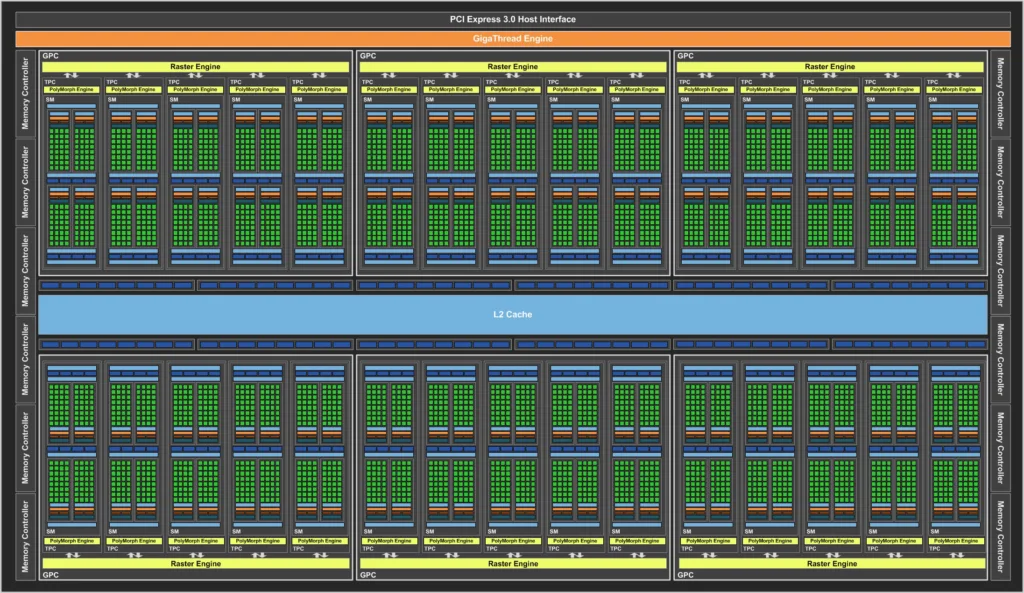
Here is the GP100 used in the Tesla GPU which is very similarly arranged to the GP102 GPU which is used for the TITAN X and also for the new Quadro P6000. GP102 is created without GP100’s Double Precision and Half Precision that scientific applications demand.

The number of SM’s are 28 on TITAN X. The full chip GP102 has 30 SMs. GP100 has 60 SMs, but note that the SM inside GP100 is configured differently, as it only has 64 Cores per SM whereas GP102 has 128 Cores per SM.
Here is the GP100 SM which has 64 cores per SM.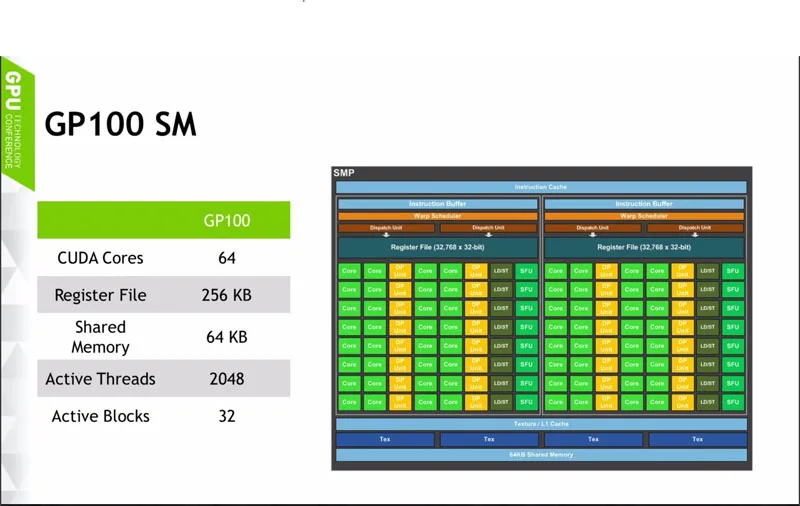
As befits a new architecture, Pascal uses a more advanced and efficient memory compression system. More effective memory compression means a significant savings in bandwidth which make for more efficiency and for faster video cards than Maxwell.
The TITAN X features 3584 CUDA cores, 12GB of GDDR5X memory running at 10Gbps, a base clock of 1.4GHz and a boost clock of 1.5GHz. The typical Boost Clock speed is 1531MHz. The Boost Clock speed is based on the average TITAN X card running a wide variety of games.
Unlike AMD’s flagship, the reference Fury X, which is a poor overclocker, Nvidia says the TITAN X can be easily overclocked. We will test this out in an upcoming evaluation in this mini-series.
Like the other Pascal cards, the TITAN X includes support for NVIDIA Simultaneous Multi-Projection technology, which allows the TITAN X to seamlessly project a single image simultaneously to both eyes, yielding a 3x VR graphics performance improvement over Maxwell GPUs. This allows TITAN X users to play VR games with higher levels of detail than similarly performing Maxwell GPUs. Simultaneous Multi-Projection is being integrated into Unreal Engine and Unity, and there are more than 30 games are already in development, including Unreal Tournament, Poolnation VR, Everest VR, Obduction, Adr1ft and Raw Data.
Specifications
Here are the specifications for the TITAN X: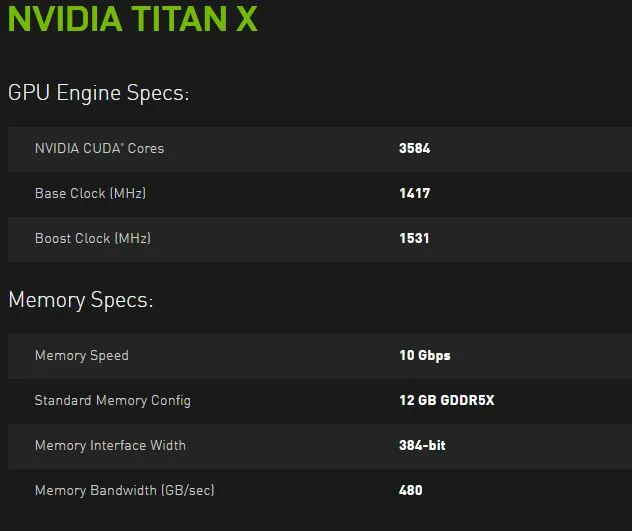
TITAN X features Peak Single Precision performance – 11 TFLOPs FP32 (32-bit floating point) and also has a new instruction set for deep learning inference, 44 TOPS INT8. It features 12GB of non-ECC GDDR5X memory for scientific applications and also for extreme resolutions in gaming.
Here are the full specifications
How does the TITAN X compare with the GTX 1080, the Maxwell TITAN X, and with their rival, AMD’s flagship Fury X?
We are going to look at the performance of just 5 games to compare the GTX 1080 with the TITAN X. Our follow-up evaluation will use our complete benchmark suite. And of course, we want to see how much the TITAN X has progressed over the Maxwell TITAN X and also by comparing it with GTX 980 Ti.
AMD’s flagship, the Fury X, is slower than the GTX 1080 and in our benchmark suite failed to win a single benchmark. The TITAN X will be in a class even higher than the GTX 1080 which easily beat AMD’s fastest card. AMD is pinning their hopes on next year’s big chip, Vega.
However, before we do performance testing, let’s take a closer look at the Pascal Titan X.
Unboxing the TITAN X
The TITAN X arrives in a sturdy box which can also be used for display.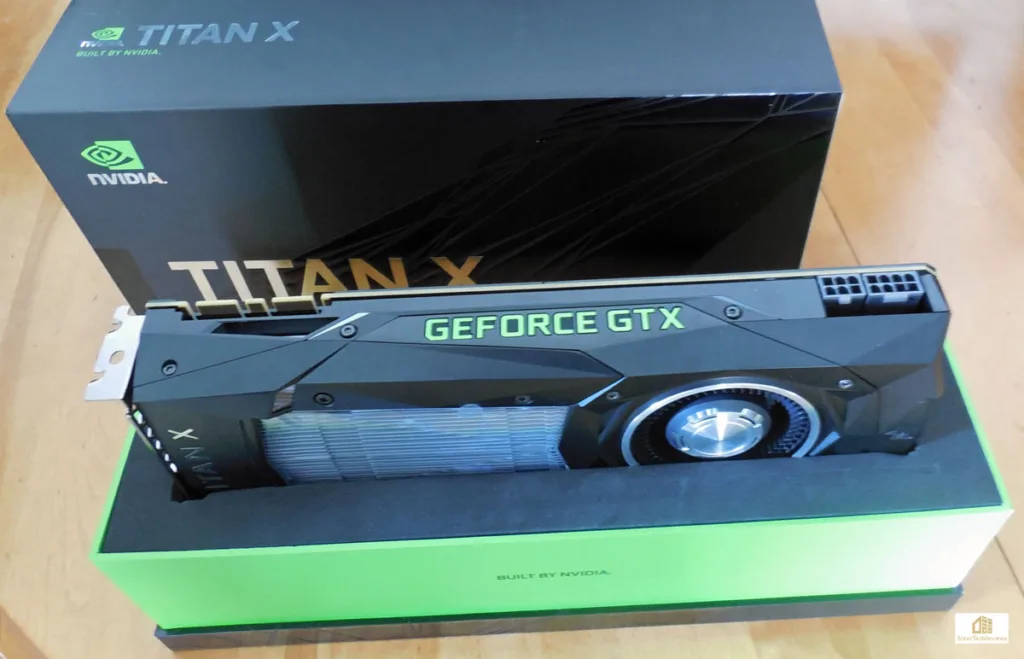
The TITAN X is made with premium materials and components, including a faceted die-cast aluminum body, and a thermal solution designed to run cool and quiet. Like the GeForce GTX 1080 Founders Edition board, a dual-FETs power supply is used to improve power efficiency, along with a low impedance power delivery network and custom voltage regulators.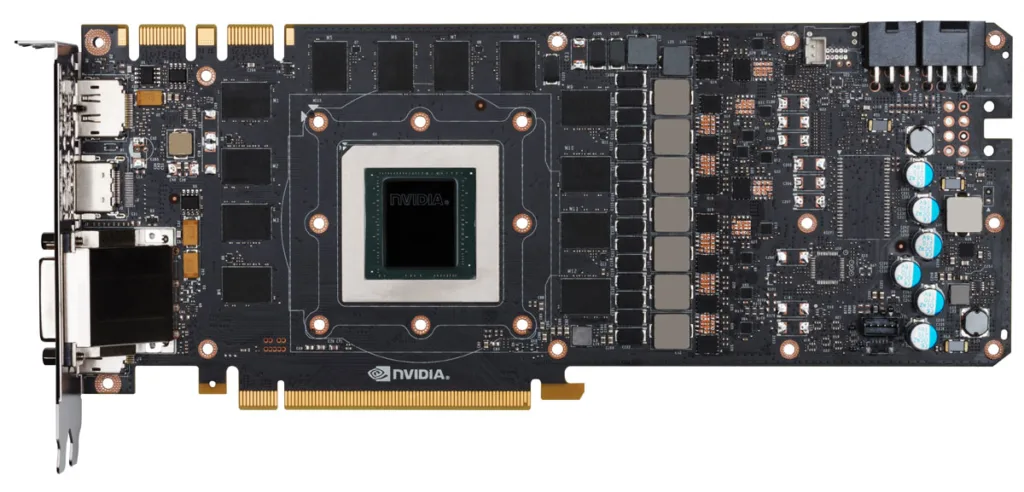
Unlike the GTX 1080 and the GTX 1070 which use a single 8-pin PCIe connector, the TITAN X uses 8-pin plus 6-pin connectors. 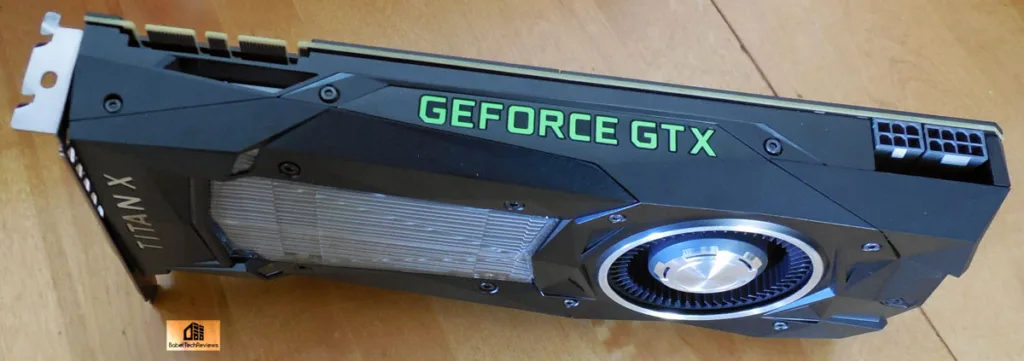
The TITAN X has been designed and built by Nvidia and it was made with premium materials and components including a faceted die cast aluminum body that definitely has a very solid feel to it. The TITAN X is built around a radial fan and featuring two copper heat pipes embedded in the base of an aluminum heatsink, and it moves all heated air outside the chassis.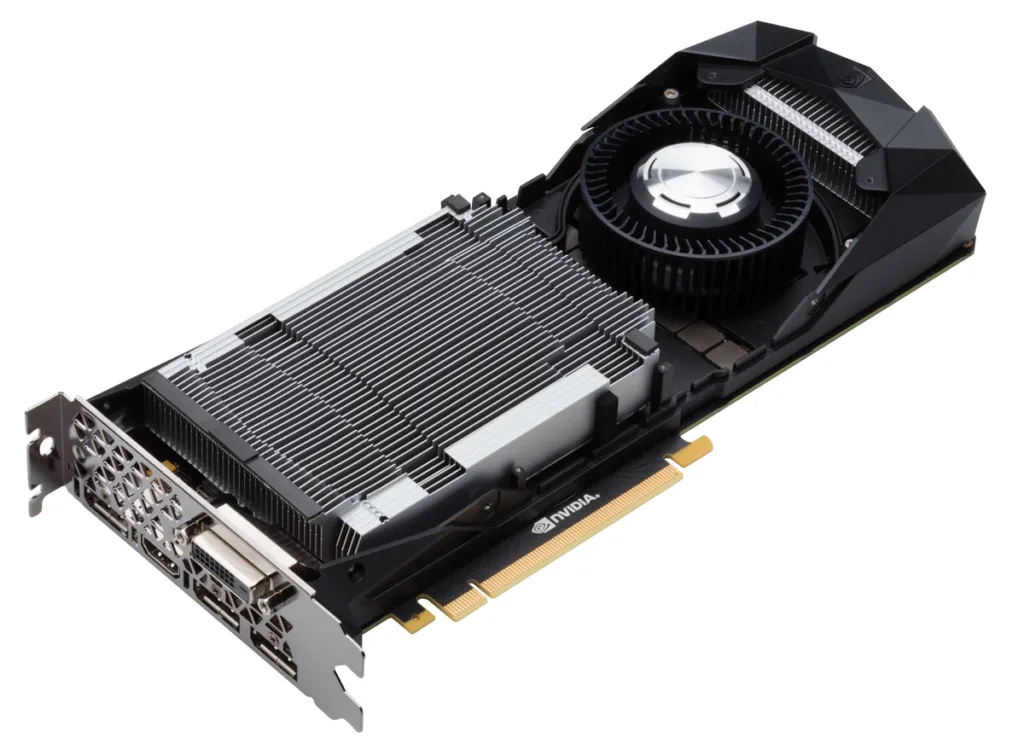
The connections are the same for all 3 Pascal cards.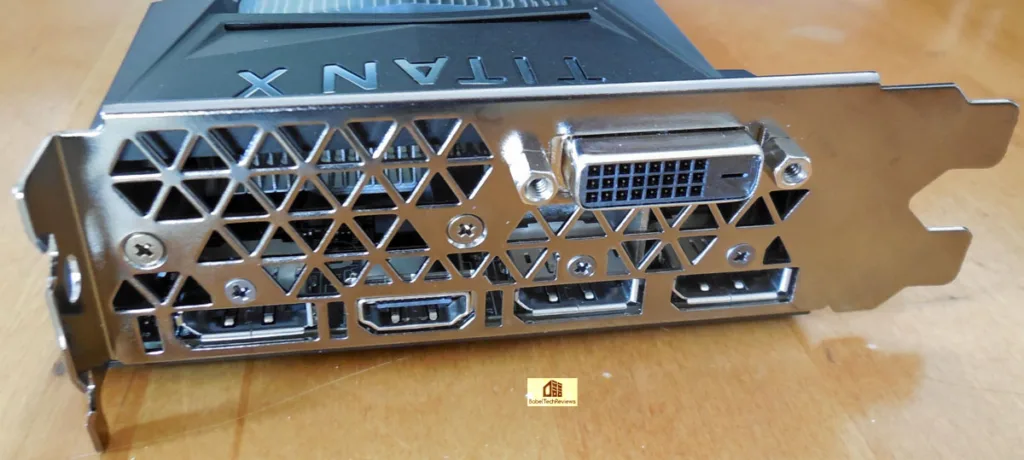 Here is the TITAN X looking at the sturdy backplate.
Here is the TITAN X looking at the sturdy backplate.
The backplate is removable for use in SLI configurations.
The Titan X is a remarkably good looking video card from any angle.
 Here is the Pascal TITAN X pictured with the Maxwell TITAN X and also with the original TITAN.
Here is the Pascal TITAN X pictured with the Maxwell TITAN X and also with the original TITAN.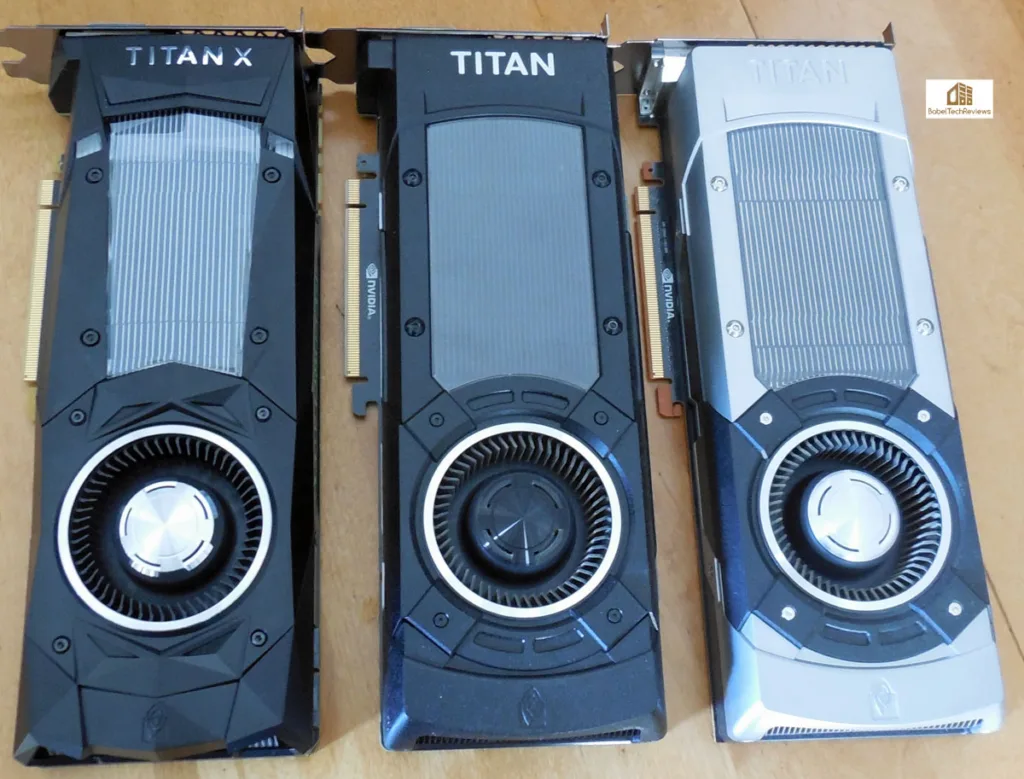 Finally, here is the traditional placement.
Finally, here is the traditional placement. The new TITAN X also looks great in any case and the GEFORCE logo lights up.
The new TITAN X also looks great in any case and the GEFORCE logo lights up.
Other Features of the TITAN X
Ansel has been Integrated into Mirror’s Edge: Catalyst and later on in the Witcher 3 this Month
The TITAN X also supports Nvidia Ansel technology, a game-capture tool that allows gamers to explore and share gaming art in new ways. With Ansel, users can compose their gameplay shots by pointing the camera in any direction and from any vantage point within a gaming world, and then capture 360-degree stereo photospheres for viewing with a VR headset or with Google Cardboard.
The first game to support Ansel is Mirror’s Edge: Catalyst, and Witcher 3: Wild Hunt, will be available later this month. More Ansel-supported games are in development, including Epic Games’ Fortnite, Paragon and Unreal Tournament; Cyan Worlds’ Obduction; Thekla’sThe Witness; Boss Key Productions’ Lawbreakers; Ubisoft’s Tom Clancy’s The Division; and No Man’s Sky from Hello Games.
VR Funhouse is now on Steam and adds TITAN X support
Nvidia VR Funhouse – the company’s VR carnival game – is now available for free from Valve’s Steam digital distribution service. Developed on Epic Games’ Unreal Engine 4, VR Funhouse will work on GTX 1080, 1070 and 1060 GPUs with HTC Vive VR headsets. It will also be open sourced to developers and artists so they can create their own VR Funhouse attractions. Of course, the very best VR experience will be on the TITAN X.
Everest VR
Beginning today, Everest VR is now available on Steam. Everest VR uses Nvidia Turbulence to create realistic snow drifts which react to wind and also interact with blowing snow and debris accurately. Nvidia’s Multi-Res Shading is used to achieve higher frame rates. Everest VR joins Raw Data and NVIDIA VR Funhouse as VR titles that support it.
EVEREST VR guides adventurers through a sequence of first-person events to simulate the climb to Mount Everest’s summit. EVEREST VR is high immersion VR and was specifically developed for the HTC VIVE.
Let’s check out the test configuration.
Test Configuration
Test Configuration – Hardware
- Intel Core i7-6700K (reference 4.0GHz, HyperThreading and Turbo boost is on to 4.4GHz; DX11 CPU graphics).
- ASRock Z7170M OC Formula motherboard (Intel Z7170 chipset, latest BIOS, PCIe 3.0/3.1 specification, CrossFire/SLI 8x+8x)
- G.Skill Ripjaws V 16GB DDR4 (2x8GB, dual channel at 3000MHz)
- GTX 1080 6GB, Founders Edition, stock clocks, supplied by Nvidia
- TITAN X (Pascal), 12GB, stock clocks, supplied by Nvidia
- 2TB Toshiba 7200 rpm HDD
- EVGA 1000G 1000W power supply unit (for both platforms)
- Thermaltake Water2.0, supplied by Thermaltake
- Onboard Realtek Audio
- Genius SP-D150 speakers, supplied by Genius
- Thermaltake Overseer RX-I full tower case, supplied by Thermaltake (Skylake)
- ASUS 12X Blu-ray writer
- Monoprice Crystal Pro 4K
Test Configuration – Software
- Nvidia’s GeForce 368.64 GTX 1060 launch drivers were used for both Nvidia cards. High Quality, prefer maximum performance, single display.
- VSync is off in the control panel.
- AA enabled as noted in games; all in-game settings are specified with 16xAF always applied
- All results show average frame rates including minimum frame rates shown in italics on the chart next to the averages in smaller font.
- Highest quality sound (stereo) used in all games.
- Windows 10 64-bit Home edition, all DX11 titles were run under DX11 render paths. Our four DX12 titles are run under the DX12 render path. Latest DirectX
- All games/SW are patched to their latest versions at time of publication.
- MSI’s latest beta version of Afterburner was used to set the Power and Temperature targets to their maximum.
-
The 5 PC Game benchmark suite & 2 synthetic tests
Synthetic
- Firestrike – Basic & Extreme
- Time Spy DX12
- DiRT Rally
DX12 Games
- Ashes of the Singularity
- Hitman
- Rise of the Tomb Raider
- Total War: Warhammer
Nvidia’s Control Panel settings:
We used MSI’s Afterburner to set our TITAN X Power and Temperature targets to their maximum.
Let’s check out our Performance Summary chart followed by our preliminary conclusion.
Performance summary chart
Here are the summary charts of 5 games and 2 synthetic tests. The highest settings are always chosen and it is usually DX11; DX12 is picked above DX11 where available, and the settings are ultra or maxed. Specific settings are listed on the performance charts. The benches were run at 2560×1440 and at 3840×2160.
All results, except for FireStrike and Time Spy, show average framerates and higher is always better. Minimum frame rates are shown next to the averages when they are available, but they are in italics and in a slightly smaller font. In-game settings are fully maxed out and they are identically high or ultra across all platforms.
The TITAN X wins every game benchmark by a significant margin of at least 15% over the world’s second fastest card, the GTX 1080.
Here is Tech of Tomorrow‘s video of the unboxing and the performance using our benchmarks.
Let’s head for our conclusion.
Conclusion
This has been quite an enjoyable if a very short 8-hour exploration for us in evaluating the new Pascal TITAN X. It did extraordinarily well performance-wise comparing it to the GTX 1080 in 5 games, and we look forward to running all 25 games of our benchmark suite in Part 2 versus the GTX 1080 using 3 resolutions instead of just two.
We are totally impressed with this top performing 6-pin plus 8-pin PCIe cabled Pascal TITAN X chip. Priced at $1200, it is certainly expensive but it stands alone as the world’s fastest gaming GPU. On top of that, it is a hybrid card well suited for Single Precision Compute and for scientific applications.
The TITAN X is an ideal card for 4K and it may well be the first video card to be able to handle maxed out settings at that extreme resolution.
Pros
- The reference design cooling is quiet and efficient; the card stays cool even on a hot Summer-like day.
- Premium VR becomes very possible with the TITAN with Simultaneous Multi-projection.
- GameWorks brings new features to gaming and to VR.
- New Fast Sync allows for high performance decoupling from the monitor, without tearing at very high frame rates. G-SYNC is useful for all other situations
- There is a solid feel to the TITAN X and the industrial design is eyecatching.
- The TITAN X is significantly faster than the second fastest card in the world, the GTX 1080.
Cons
The Verdict:
 If you want the fastest video card available today, the TITAN X at $1200 is in a class by itself, easily topping the performance of the GTX 1080 which was the fastest card until today at $699.
If you want the fastest video card available today, the TITAN X at $1200 is in a class by itself, easily topping the performance of the GTX 1080 which was the fastest card until today at $699.- We would like to award the TITAN X the BabelTechReviews Editor’s Choice Award for gamers who demand the fastest single-GPU card, where price is no object.
We do not know what the future will bring, or even if Nvidia will bring out a GTX 1080 Ti, but the TITAN X brings the top performer to the Pascal GeForce family right now. With great forward looking features, you can be assured of immersive gaming by picking this card for 4K, 2K, or even 2560×1440 at a minimum, and especially for outstanding VR performance.
Stay tuned, there is a lot coming from us at BTR. Next, in our continuing TITAN X series, we will test the TITAN X with our full benchmark suite versus the GTX 1080 and later, versus the Maxwell Titan X and the GTX 980 Ti. However, first, we have a brand new card to evaluate on Thursday morning.
Happy Gaming!






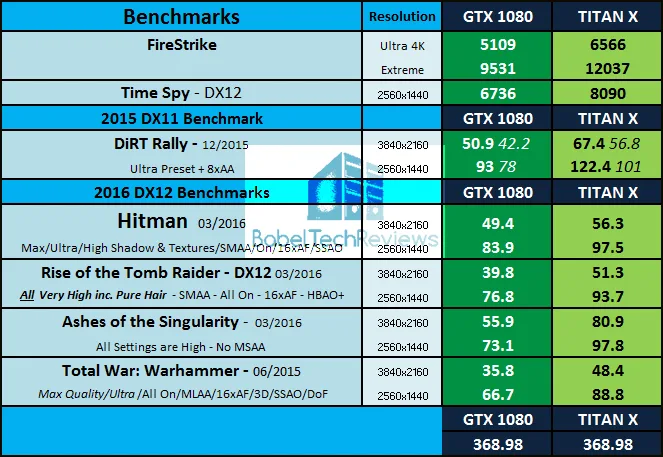
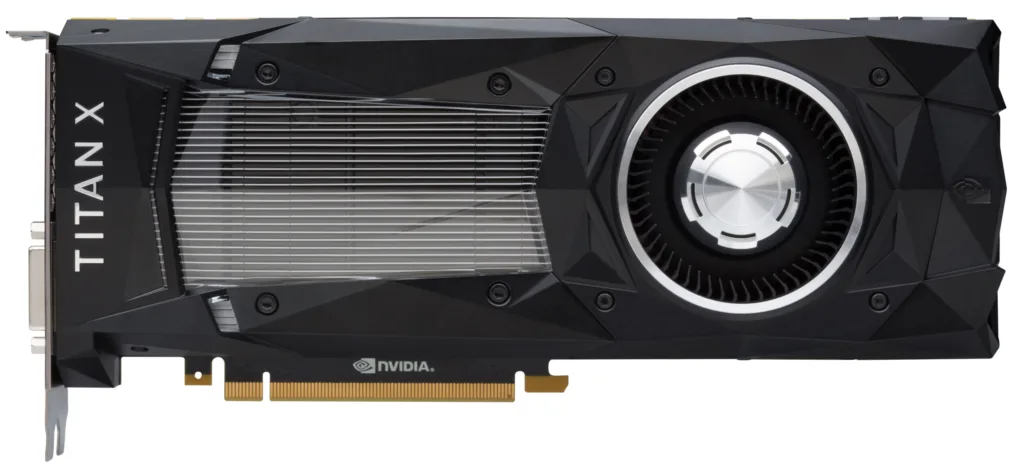
Comments are closed.